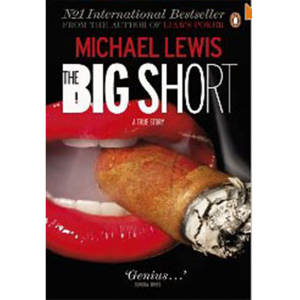 Michael Lewis’s 1989 Liar’s Poker, exposed the shenanigans of Wall Street bond-trading house Salomon Brothers at their greatest prosperity in the mid eighties. The Traders of Salomon were a mercenary bunch of ignorant, gluttonous, hooligans who didn’t get what they deserved…
Michael Lewis’s 1989 Liar’s Poker, exposed the shenanigans of Wall Street bond-trading house Salomon Brothers at their greatest prosperity in the mid eighties. The Traders of Salomon were a mercenary bunch of ignorant, gluttonous, hooligans who didn’t get what they deserved…
Treacherous to everyone in every way – from colleagues, superiors, juniors and customers, this shower, including Lewis himself, were both charming and obnoxious in equal amounts. Aware of his own corruption at Salomon brothers, Lewis shouts out about his now modest year-end bonus. With a confident and vivid style, Lewis narrates that which had long been suspected, that if the commercial banks have had haphazard management over the years, Investment banks take mismanagement to a whole new level. While they make the governance and their elite very rich, the entities themselves can handle neither success nor failure properly, as exposed since 2008.
In his new book, Lewis is now neither obnoxious nor charming. The skies have fallen. The market Wall Street created in the housing debt of the very poorest Americans, so-called “sub-prime” mortgage bonds and various derivative securities, which fell to bits in 2007 and all but engulfed the world in 2008, is the greatest financial fraud since the 18th century. Men and women who once made us laugh now make us shudder. In other words, The Big Short is not half the fun of Liar’s Poker, but it is more important.
In it, Lewis presents the aboriginal division in financial markets between two character types: the bull and the bear, or, as they are now known, the long and the short. Whereas a long buys a security he does not own in the hope of it rising in price so he can sell at a profit, a short sells a security that he does not own in the belief that it will fall in price and that, before the time he is required to deliver it, he can buy it more cheaply. If the long is all glory and imagination, the short is angry, withdrawn, solitary, utterly persuaded of his own righteousness.
Lewis tells the distinct stories of three groups of little-known financiers, who ended up being short several hundreds of million dollars of sub-prime mortgage securities in 2008. They are Steve Eisman and his friends at a hedge fund called FrontPoint; Michael Burry of Scion Capital; and Charlie Ledley and his friends of Cornwall Capital Management.
Do not expect the characters of Liar’s Poker. Here there is no Human Piranha, no Opportunist, no Chairman John Gutfreund, who is as perfect an amalgam of vanity and treachery as you could find outside Shakespeare. Eisman thinks he is Spider Man, while Burry cuts himself off from the world behind a glass eye and Asperger’s syndrome. (As he remarks: “Only someone who has Asperger’s would read a sub-prime mortgage-bond prospectus.”)
Yet from these unpromising characters, Lewis creates magnificent financial set-pieces, such as a sub-prime bond conference in Las Vegas in January 2007. While the financiers extol their new market, a stripper has five home loans she cannot hope to repay. At the gala dinner, Eisman sits next to a mortgage-bond seller called Wing Chau so ignorant and complacent that he bursts out: “Whatever that guy is buying, I want to short it.”
The short trade these men make is now well known: an insurance policy against each bond known as a credit default swap, first sold by AIG Financial Products in London and then by Goldman Sachs and the Wall Street houses. For Lewis, it was Burry who first realised that a mortgage issued to a Mexican strawberry-picker with no English and $15,000 a year in Bakersfield, even if it was packaged up with the stripper’s loans into a tradeable security, repackaged with other bad mortgage securities into collateralised debt obligations and slapped with an investment-grade rating by ratings agencies such as Moody’s, nonetheless remained a mortgage issued to a Mexican strawberry picker with no English and $15,000 a year in Bakersfield.
The sub-prime mortgage-bond market was a “credit laundering service for the residents of lower-middle-class America” and would default just as soon as the low or “teaser” interest rates on the loans expired some time in 2007 and the interest became unaffordable. The slow collapse of the market through 2007 and 2008 makes terrific reading. Lewis’s investment bankers, in attempting to befuddle their customers and the market authorities, ended up befuddling themselves. “In the course of trying to figure it out,” said Ledley, “we realise that there’s a reason why it doesn’t quite make sense to us. It’s because it doesn’t quite make sense.”
Lewis, who lives in Paris, is too worldly to make his parade of short misfits and fantasists into American heroes. In one of those moments of self-knowledge that strike even financiers, Eisman understands that he was shorting not Wall Street but humanity itself. More to the point, by providing liquidity on the short side, these men kept the market in sub-prime securities going. “We fed the monster until it blew up,” he says.
What came next is unbearable. Wall Street, backed by a discredited economics profession, assorted poltroons, and its friends in Washington, notably the treasury secretary, Hank Paulson (formerly of Goldman Sachs), terrified the federal government into handing over billions of dollars and paying AIG’s debts to Goldman Sachs. The American public has not yet grasped the nature and extent of this crime – but it will, it will.
| Title | The Big Short: Inside the Doomsday Machine |
| Author | Michael Lewis |
| first published | November 2009 |
| Publisher | W. W. Norton Company |
| ISBN | 039335315X |
| Language | English |
